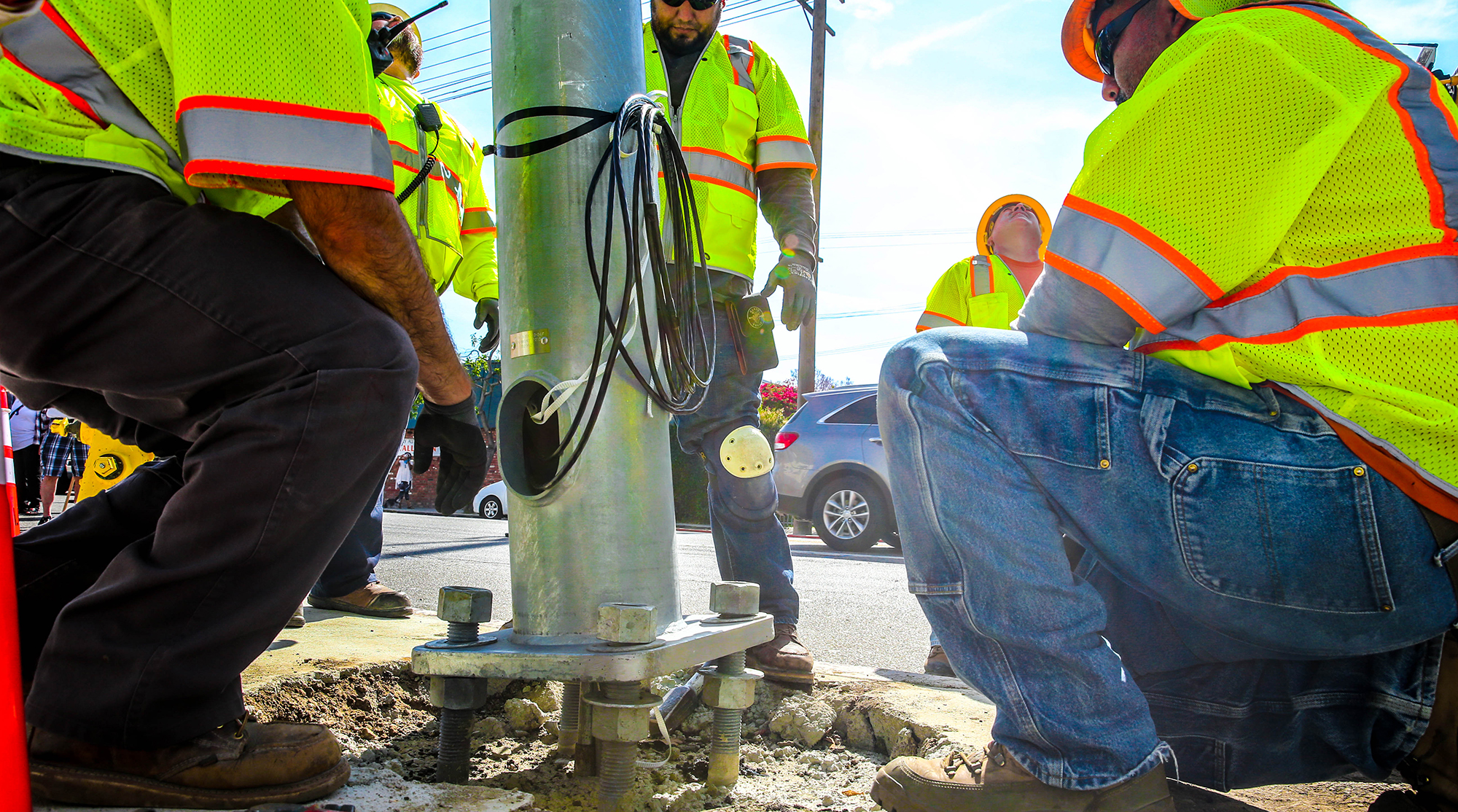LADOT development service counters continue to process building permits remotely and virtually until further notice. Although all development service counters have been reopened, in-person service is only available when needed and by appointment only. Please use the information link below to locate the appropriate office contact for your project.
WEST LOS ANGELES DEVELOPMENT REVIEW
Mail: 7166 W. Manchester Avenue, Los Angeles, CA 90045
E-mail: ladot.devreview.wla@lacity.org
Prior to submitting your request for assistance, please complete the LADOT Clearance Questionnaire form and include the completed form with your request.
VALLEY DEVELOPMENT REVIEW
Mail: 6262 Van Nuys Boulevard, 3rd Floor Room 320, Van Nuys, CA 91401
E-Mail: ladot.devreview.sfv@lacity.org
LADOT CITYWIDE ONE-STOP COUNTER
Mail: 201 N. Figueroa Street, 5th Floor, Los Angeles, CA 90012
E-Mail: ladot.onestop@lacity.org
The LADOT Development Review section includes three geographically focused offices (Metro, Valley, and West Los Angeles) providing several services, including building permit review and sign-off, site plan and driveway plan review, project condition clearance, site access and circulation consultation, transportation specific plan compliance, investigation of street vacation requests, and the review of transportation assessments and environmental impact reports that typically involve the design and evaluation of transportation mitigations.
LADOT Development Review fees and applicable Specific Plan fees may apply. Check with LADOT staff to confirm current fee rate schedules.
Notice to Department of Transportation Industry Professionals
If you are compensated to interact with the Department of Transportation, City law may require you to register as a lobbyist and report your activity. Any individual may qualify as a lobbyist, regardless of occupation, education, training, or professional title. A lobbyist may hold a position that includes but is not limited to attorney, CEO, consultant, government liaison, business owner, permit applicant, engineer, expediter, land developer, dockless mobility operator, taxicab and fleet operators, transportation assessors, sustainable development planners, various real estate professionals, and others.
More information is available online through the Ethics Commission’s lobbying program and publication pages. For assistance, please contact the Ethics Commission.
Below are the currently active transportation specific plan fee programs. It should be noted that all fee programs are updated annually so please contact the appropriate development review office to obtain the current applicable fee table.
- Coastal Transportation Corridor and West Los Angeles (ladot.devreview.wla@lacity.org)
- Warner Center and Ventura/Cahuenga Corridor (ladot.devreview.sfv@lacity.org)
- Central City West (ladot.devreview.cen@lacity.org)
Please review the following memo for updated information on LADOT's Development Services Counters.
Customer Support Centers:
LADOT Citywide One-Stop Counter
201 N. Figueroa Street, 5th Floor
Los Angeles, CA 90012
(213) 482-7024
ladot.onestop@lacity.org
All areas south of Mulholland Drive and east of Robertson Boulevard
100 S. Main Street, 9th Floor
Los Angeles, CA 90012
ladot.devreview.cen@lacity.org
West Los Angeles Development Review
All areas south of Mulholland Drive and west of Robertson Boulevard including San Pedro
7166 W. Manchester Avenue
Los Angeles, CA 90045
(213) 485-1062
ladot.devreview.wla@lacity.org
San Fernando Valley (north of Mulholland Drive)
6262 Van Nuys Boulevard, 3rd Floor Room 320
Van Nuys, CA 91401
(818) 374-4699
ladot.devreview.sfv@lacity.org

LADOT must review and approve all driveway dimensions, project access, and circulation plans for new developments.
In order to minimize and prevent last minute building design changes, the applicant should contact LADOT early in the design process for driveway width and internal circulation requirements so that such traffic flow considerations are designed and incorporated early into the building and parking layout plans. Please note, driveways must comply with the Driveways Standard Plan S-440-4. Here is a copy of the current LADOT Driveway, Access, Circulation Design Guidelines.
LADOT’s Citywide Planning Coordination Section
201 N. Figueroa Street, 5th Floor, Room 550
213-482-7024
Have a complaint, comment, or commendation? Click the link below to let us know.

The City requires the preparation and submission of a transportation assessment for development projects or transportation projects that meet the following criteria:
- If the development project is estimated to generate a net increase of 250 or more daily vehicle trips and requires discretionary action, a transportation assessment for a development project is required.
- If a transportation project is likely to either: (1) induce additional vehicle miles traveled by increasing vehicle capacity; or (2) reduce roadway through-lane capacity on a street that exceeds 750 vehicles per hour per lane for at least two (2) consecutive hours in a 24-hour period after the project is completed, a transportation assessment is generally required.
- A transportation assessment is required by City ordinance or regulation.
The City strongly recommends that the Project Applicant and/or consultants contact LADOT staff early in the project design phase to establish the scope of the transportation assessment. For additional information, please refer to the Los Angeles Department of Transportation (LADOT) Transportation Assessment Guidelines document.
Important Links:
Transportation Study Assessment - Department of Transportation Referral Form
Transportation Study Assessment - Department of Transportation Referral Form: The Los Angeles Department of Transportation (LADOT) Referral Form serves as an initial screen to determine whether a development project requires a transportation assessment.
LADOT Transportation Assessment Guidelines
LADOT Transportation Assessment Guidelines.
Memo on Pandemic‐related updates to LADOT’s Transportation Assessment Requirements.
Memo regarding Interim Guidance for Freeway Safety Analysis.
LADOT Transportation Assessment Guidelines Addendum on Hillside Developments.
Latest Attachment C:Transportation Assessment Memorandum of Understanding (MOU) and Attachment C.1: Access Assessment Criteria.
Memo on the Transportation Assessment Guidelines Update 2021 and Attachment: Traffic Signal Warrant
The City of Los Angeles VMT Calculator is an Excel tool to determine the number of trips and VMT generated by a development project. For more information on the VMT Calculator, please consult the VMT Calculator User Guide, VMT Calculator Documentation, and TDM Strategy Appendix.
The City Council File provides more information on how the City updated its transportation evaluation metrics to comply with Senate Bill 743.
Open House and Public Hearing Boards
The Open House and Public Hearing Board presentation provides additional information on the CEQA Appendix G and Transportation Section Update.
Presentation to the City Planning Commission - February 28, 2019
The CEQA Transportation Section Update that was presented to the City Planning Commission on February 28, 2019.
Presentation to the City Planning Commission - February 28, 2019

LADOT and the Department of City Planning (DCP) will soon announce new requirements to encourage more sustainable development projects. Los Angeles will continue to grow. These requirements are critical to ensure the City responsibly addresses the needs of its residents, businesses, and visitors. Encouraging people to take transit, carpool, walk, bike, and scoot will help improve our environmental outcomes, our air quality, and our quality of life. New requirements are designed to help new commercial, residential, office and mixed use developments adapt to changing transportation needs.
More information will be posted in Summer 2020.
An update to the City’s development ordinance is long overdue. The current 25-year-old ordinance no longer meets the needs of a modern, growing city. It does not account for on-demand and shared mobility services that have changed people’s travel behavior in recent years. New mobility services, such as bike share, car share, on-demand rides, and other smart technologies offer more options than we ever could have imagined in 1993.
How Was the Ordinance Developed?
To update the ordinance, City staff began by conducting a review of best practices across the country. Staff then coordinated with local, regional, and state agencies to align our goals and strategies. Throughout the process, staff engaged with community groups, residents, business associations, and other stakeholders to ensure the ordinance could meet Los Angeles’s unique context.
New requirements aim to improve people’s access to destinations as the population grows. Shifting travel from driving alone (single-occupancy-vehicle (SOV) trips) to sustainable travel choices will minimize the impacts of new developments on the transportation system.
- Better environmental and public health outcomes: Shifting travel away from SOV trips will improve air quality, promote public health, reduce vehicle miles travelled (VMT), and cut public and personal costs.
- Improved quality of life: Improving the quality of travel experience and the well-being of travelers will make the transportation system more useful, usable, desirable, findable, accessible, and credible.
- Context-sensitive solutions: New requirements are designed to meet the needs of diverse communities by offering a wide menu of choices for each development. These options account for land-use and transportation variations citywide. A flexible program will best serve people and neighborhoods with mobility solutions.
- Adaptive by design: City staff can periodically update development requirements to ensure the program is responsive to new mobility technologies and innovations and to evolving travel preferences and needs. Applicants may also suggest new measures for consideration.
- Streamlined project review, monitoring, and evaluation: LADOT will commit to provide project applicants with a clear and predictable process to obtain project approval as well as yearly opportunities to alter their plan should monitoring and evaluation demonstrate a need for adjustment. Regular project performance monitoring and evaluation ensures a transparent process efficient for both the applicant and the City.
- Program performance evaluation: LADOT will analyze data to measure whether new requirements are effective at achieving program goals and providing the greatest public benefit. The City can utilize this data to inform future transportation and land-use planning.

